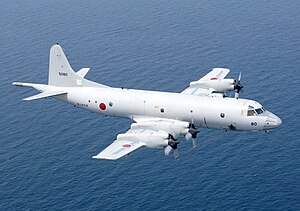
Back Lockheed P-3 Orion Afrikaans لوكهيد بيه-3 أوريون Arabic Lockheed P-3 Orion Byelorussian Lockheed P-3 Orion BE-X-OLD Lockheed P-3 Orion Catalan Lockheed P-3 Orion Czech P-3 Orion Danish Lockheed P-3 German Lockheed P-3 Orion Greek Lockheed P-3 Orion Spanish
| P-3 Orion | |
|---|---|
 A Kawasaki-built P-3C Orion of the Japan Maritime Self-Defense Force | |
| General information | |
| Type | Maritime patrol aircraft |
| National origin | United States |
| Manufacturer | Lockheed Lockheed Martin Kawasaki Aerospace Company |
| Status | Active |
| Primary users | United States Navy |
| Number built | Lockheed – 650, Kawasaki – 107, Total – 757[1] |
| History | |
| Manufactured | 1961–1990[2] |
| Introduction date | August 1962[3] |
| First flight | November 1959[3] |
| Developed from | Lockheed L-188 Electra |
| Variants | Lockheed AP-3C Orion Lockheed CP-140 Aurora Lockheed EP-3 Lockheed WP-3D Orion |
| Developed into | Lockheed P-7 |
The Lockheed P-3 Orion is a four-engined, turboprop anti-submarine and maritime surveillance aircraft developed for the United States Navy and introduced in the 1960s. Lockheed based it on the L-188 Electra commercial airliner; it is easily distinguished from the Electra by its distinctive tail stinger or "MAD" boom, used for the magnetic anomaly detection (MAD) of submarines.
Over the years, the P-3 has seen numerous design developments, most notably in its electronics packages. Numerous navies and air forces around the world continue to use the type primarily for maritime patrol, reconnaissance, anti-surface warfare and anti-submarine warfare.[3] A total of 757 P-3s have been built. In 2012, it joined the handful of military aircraft including the Boeing B-52 Stratofortress, Boeing KC-135 Stratotanker, and Lockheed C-130 Hercules that the United States military has been using for more than 50 years. In the twenty-first century, the turbofan-powered Boeing P-8 Poseidon began to supplement, and will eventually replace, the U.S. Navy's P-3s.
- ^ "P-3 production." Archived 1 September 2011 at the Wayback Machine p3orion.nl. Retrieved: 7 June 2011.
- ^ Cite error: The named reference
aeroflight2010was invoked but never defined (see the help page).